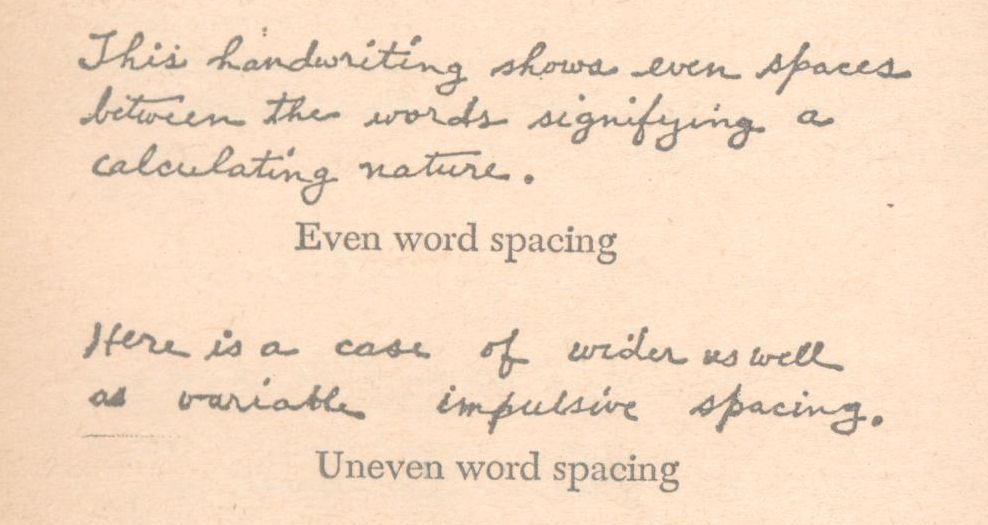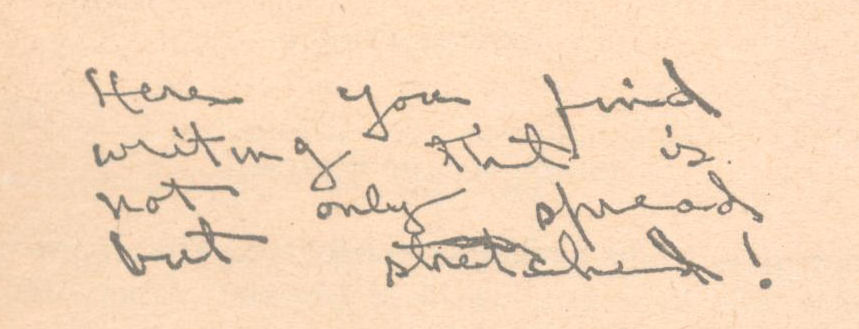7.5 LETTER SPACING
7.5 LETTER SPACING
******************
This covers various features of a person’s handwriting, all giving indications of character. First and most obvious is — WORD SPACING which falls into one of two categories, either writing in which the words are uniformly spaced, or uneven, irregular spacing between the words of a sentence.

These, more than line spacing, are a sure index to a person’s flow of thought, whether his ideas are clear and calculated or subject to impulse and hasty decision. Even spaces show calculation; uneven spaces, impulse.
CONNECTED WRITING
*****************
This comes under the head of spacing, or the lack of it—as it is a form of writing in which all the letters of each word is connected.
It shows a person of a positive nature, firm in decision and very exacting, one who will not make allowance for repeated mistakes. It shows a good manager, all the more so if words—as well as letters—are connected. It is also the mark of the outright skeptic.

BROKEN WRITING
**************
Where certain letters are disconnected—not too frequently — we find a person who plays hunches and is a keen judge of human character. You can almost catch the rhythm in this writing, the occasional lifting of the hand, like a pianist moving to another key. A fine flow of thought but with quick, inspirational touches. Most talented persons use this style.

DISCONNECTED WRITING
********************
Here, practically no letters connected. This represents the dreamer who lives in a world of complete fancy, depending upon intuition rather than reason, seldom descending to the dull realm of reality. This writing shows a poetic trend and a love of nature. It must not be confused, however, with printed lettering, which some people use in order to make reading easier.

CRAMPED VERSUS SPREAD
*********************
No greater contrast in spacing can be shown than in the following examples, one representing cramped writing and the other spread writing.
Both are totally self-expressive: the cramped style shows a desire to save space, particularly when words are jammed together at the end of a line. This, of course, shows an inherent urge to avoid waste, especially if the lines are close together.

That, in turn, indicates caution in money matters, a keen bargainer, a person of a somewhat suspicious nature, who is always holding on to what he has. It is a trait that shows itself strikingly as well as quite unconsciously through this sort of writing.
In spread writing, we see sheer extravagance, a nature often given to abandon, one that places social life and good times at the top of the list.

This is the mark of the spender, the carefree spirit. As a result, it usually shows a friendly type of person, but one who is seldom at all systematic. These writers have a wonderful ability at forgetting what they do not want to remember.
As one experienced graphologist put it: “If you think there’s nothing harder than getting a cramped writer to lend you money, just ask a spread writer to give you back what he borrowed.”
Cramped versus spread is just about the equivalent of cash verses credit.







Leave a Reply